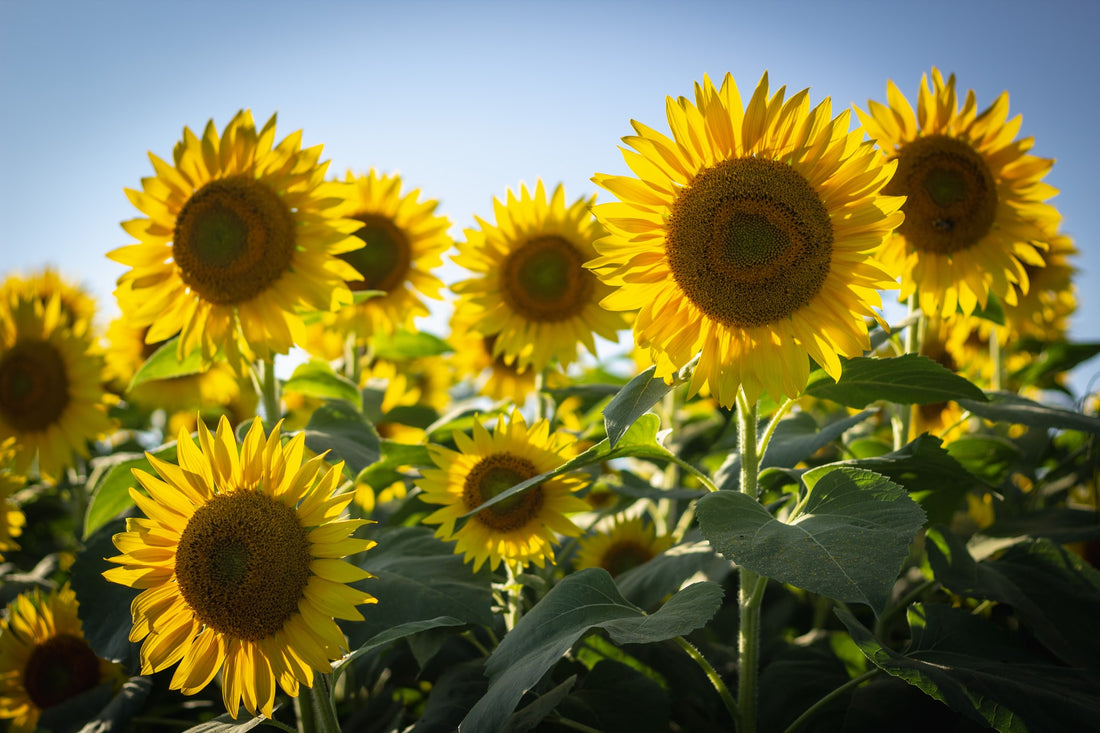5 Reasons To Grow Sunflowers
- The large and spectacular blooms that last for months.
- Beneficial to pollinator species and wildlife. Native bees love the nectar; songbirds love the seeds.
- Fuss-free & hardy.
- Sunflowers detox contaminated soils by absorbing heavy metals and chemicals.
- Sunflower seeds are delicious! Plant enough flowers for yourself and the birds to snack on.
About Sunflowers
The most well-known sunflower varieties feature bright golden yellow blooms with a dark brown center. However, sunflowers also come in other colors, including orange, maroon, red, and brown, as well as many shades of yellow.Sunflowers are heliotropic; this means they move with the sun. Sunflowers literally turn their face to the sun, tracking it across the sky from east to west, and then return to face the east at the end of the day, prepared for the next morning's sun. They do this primarily when they are young, before their flower heads get too heavy to turn easily.
Sunflower Planting Tips & FAQ
- Plant sunflowers in full sun – they need at least 6 hours of direct sunlight per day
- These flowers will grow in poor, rocky, and imperfect soils, but do best in well-draining, rich dirt. They do not like being waterlogged.
- The tallest varieties benefit from being planted along a fence or backdrop which can support their tall, top-heavy growth. The tall ones make an amazing living wall.
- Sunflowers are available as annuals or perennials. The common garden sunflower varieties are almost always annuals.
- Plant seeds every two weeks for a continuous succession of sunflower blooms.
- Some sunflowers are cultivated to be pollen-free, which is great for bouquets, but terrible for pollinators and beneficial insects. Please avoid these unless pollen is a major issue for you.
- Sunflowers are drought-tolerant, heat-tolerant, and rarely suffer from pests or disease.
- These flowers grow well in pots and containers, though it's best to choose smaller varieties for this.
- The enormous variety of sunflower species, cultivars, and hybrids includes plants that grow over 16 feet tall, to ones that just barely reach a foot tall.
Sunflower Varieties:
- Mammoth Grey Stripe -- The classic enormous sunflower with golden yellow petals and a dark brown center. Grows up to 12 feet tall.
- Autumn Beauty -- A unique sunflower with red, bronze, burgundy, and yellow petals. Grows 5-8 feet tall.
- Lemon Queen -- A sweet sunflower with light lemon yellow petals; grows 5-7 feet.
- Teddy Bear Dwarf -- Unique ultra-fuzzy orange-yellow petals. Grows 2-3 feet tall.
- Velvet Queen -- Stunning dark burgundy petals with dark center circle. Grows up to 5 feet tall.
How To Grow Sunflowers From Seed
It's best to sow sunflower seeds directly in the garden after all danger of frost has passed. They are also fine started indoors and transplanted, but that usually isn't necessary since they germinate and sprout readily in the garden in most climates.
Planting time is usually mid-March to early April in the south, and between April to May in northern climates. If you've got a shorter growing season, choose a variety that doesn't take as long to reach maturity.
- Sow sunflower seeds 1-1.5 inches deep and 6 inches apart.
- Water the soil thoroughly after planting.
- You may need to spread row covers or netting over the seeds if you see birds (especially crows!) digging them up. Once the seeds sprout and get a few inches tall, birds will leave them alone.
- After the seedlings reach 6 inches tall, thin them to 30 inches apart.
Sunflower Care
- Water the base of the plants weekly and thoroughly to encourage deep root growth. Once the plants are established, it's best to err on the side of underwatering as opposed to overly moist soil. During droughts, they may need more frequent watering.
- Do not fertilize sunflower plants unless the soil is extremely poor. Fertilization causes stem breakage later in the season when the flower heads get heavy.



